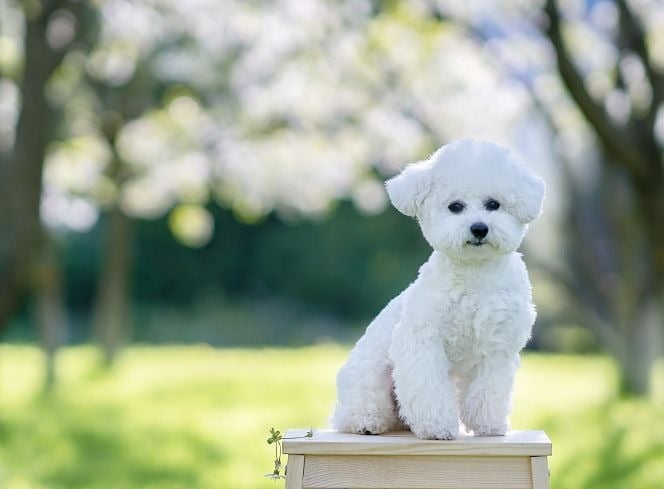Welcome to the comprehensive guide on Bichon Frises, your ultimate resource for understanding the personality, traits, health, training, exercise needs, and care tips for these adorable fluffy companions. Whether you're a seasoned Bichon Frise owner or considering adding one to your family, this guide aims to provide valuable insights and practical advice to ensure a harmonious relationship with your furry friend. To shop our Bichon Frise must haves, click here
Unveiling Bichon Frise Personality and Traits
Bichon Frises are renowned for their charming personalities and delightful traits. Affectionate, playful, and sociable, these little dogs thrive on human companionship and love to be the centre of attention. Their cheerful disposition and gentle nature make them excellent family pets and companions for individuals of all ages. Bichons are known for their intelligence, agility, and eagerness to please, which makes them relatively easy to train and enjoy learning new tricks.
Exploring Bichon Frise Facts and Information
- Originating from the Mediterranean region, Bichon Frises belong to the toy dog breed group and have a long history as beloved companions and entertainers.
- Their distinctive fluffy white coat is hypoallergenic and requires regular grooming to prevent matting and maintain their signature appearance.
- Bichons are generally healthy dogs with a lifespan of 12 to 15 years.
Understanding Bichon Frise Health Issues

While Bichon Frises are generally robust dogs, it's essential to be aware of potential health issues that may affect them.
- Allergies: Bichons may develop skin allergies, so it's essential to monitor their diet and environment.
- Dental Health: Regular dental care is vital to prevent dental issues in these small breeds.
- Ear Infections: Bichon Frises are susceptible to ear infections due to their floppy ears, necessitating regular cleaning.
Regular vet check-ups, a balanced diet, proper dental care, and regular exercise can help maintain their overall health and well-being.
Bichon Frise Training: Tips for Success
Training a Bichon Frise requires patience, consistency, and positive reinforcement techniques. Start training early to establish good habits and prevent behavioural issues. Use rewards such as treats, praise, and playtime to motivate your Bichon and make learning fun and engaging.
House Training a Bichon Frise Puppy
House training a Bichon Frise puppy can be a rewarding experience with the right approach. Establish a consistent schedule for feeding, toilet breaks, and crate training. Supervise your puppy closely indoors and provide ample opportunities for outdoor elimination. Accidents may happen, but with patience, consistency and positive reinforcement, your Bichon will learn the ropes of house training.
Bichon Frise Exercise Needs: Keeping Them Active and Healthy

Despite their small size, Bichon Frises are energetic dogs that require regular exercise to stay healthy and happy. Daily walks, play sessions, and interactive toys can help fulfil their exercise needs and prevent boredom. However, it's essential to avoid overexertion, especially in hot or humid weather, as Bichons can be sensitive to extreme temperatures.
Our favourite walking accessories for Bichon Frises are the Cocopup range, they come in so many cute patterns and colours and have a big range of sizes to pick from so you're sure to get the perfect fit for your Bichon Frise.
Raising a Bichon Frise Puppy: Nurturing Their Development
Raising a Bichon Frise puppy involves providing them with love, care, and proper socialisation from an early age. Expose your puppy to various people, animals, and environments to help them develop into well-adjusted and confident adults.
Establish routines, boundaries, and positive reinforcement techniques to foster good behaviour and strengthen your bond with your Bichon.
Optimal Nutrition: Best Dog Food for Bichon Frise
Choosing the right dog food is crucial for your Bichon Frise's overall health. Look for high-quality, well-balanced options that cater to their specific needs. For a well balanced option we recommend trying either Orijen or Acana, they have your dog’s nutritional needs at the forefront
Best Dog Food for Bichon Frise Puppy
Puppies have unique nutritional requirements. Select a premium puppy formula rich in essential nutrients to support their growth and development. We love the Purina ProPlan formulations for puppies!
Best Beds for Bichon Frises: Creating a Cosy Retreat
Bichon Frises love to curl up in a comfortable spot to rest and recharge. Invest in a soft, supportive bed that provides adequate cushioning and promotes proper alignment for your Bichon's joints. Why not try one of our High Wall Beds? The high cosy sides encourage them to curl up and the comfy cushion is supportive!
In conclusion, Bichon Frises are cherished companions known for their endearing personality, playful demeanour, and unwavering loyalty. By understanding their unique traits, addressing their health needs, providing proper training and care, and selecting the right products, you can ensure a fulfilling and rewarding relationship with your beloved Bichon Frise for years to come.
Remember, the bond you share with your Bichon Frise is a special one, filled with love, joy, and unforgettable moments. Embrace each day together and cherish the pawprints they leave on your heart.
Here's to many wagging tails and endless cuddles with your beloved Bichon Frise!

































































































